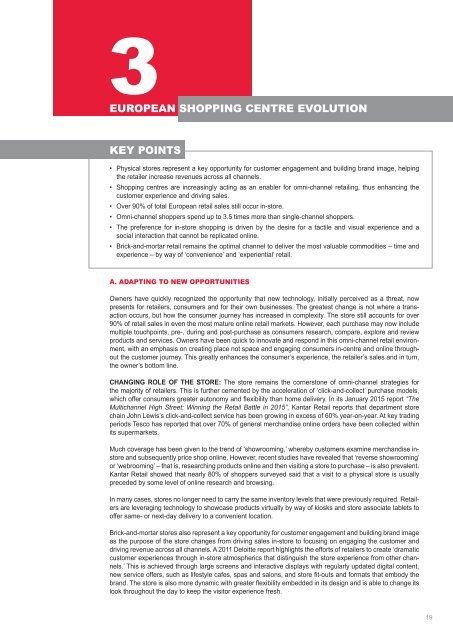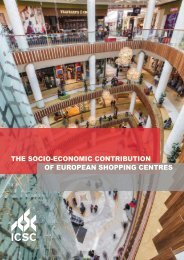THE SOCIO-ECONOMIC CONTRIBUTION OF EUROPEAN SHOPPING CENTRES
Create successful ePaper yourself
Turn your PDF publications into a flip-book with our unique Google optimized e-Paper software.
3<strong>EUROPEAN</strong><br />
<strong>SHOPPING</strong> CENTRE EVOLUTION<br />
KEY POINTS<br />
• Physical stores represent a key opportunity for customer engagement and building brand image, helping<br />
the retailer increase revenues across all channels.<br />
• Shopping centres are increasingly acting as an enabler for omni-channel retailing, thus enhancing the<br />
customer experience and driving sales.<br />
• Over 90% of total European retail sales still occur in-store.<br />
• Omni-channel shoppers spend up to 3.5 times more than single-channel shoppers.<br />
• The preference for in-store shopping is driven by the desire for a tactile and visual experience and a<br />
social interaction that cannot be replicated online.<br />
• Brick-and-mortar retail remains the optimal channel to deliver the most valuable commodities – time and<br />
experience – by way of ‘convenience’ and ‘experiential’ retail.<br />
A. ADAPTING TO NEW OPPORTUNITIES<br />
Owners have quickly recognized the opportunity that new technology, initially perceived as a threat, now<br />
presents for retailers, consumers and for their own businesses. The greatest change is not where a transaction<br />
occurs, but how the consumer journey has increased in complexity. The store still accounts for over<br />
90% of retail sales in even the most mature online retail markets. However, each purchase may now include<br />
multiple touchpoints, pre-, during and post-purchase as consumers research, compare, explore and review<br />
products and services. Owners have been quick to innovate and respond in this omni-channel retail environment,<br />
with an emphasis on creating place not space and engaging consumers in-centre and online throughout<br />
the customer journey. This greatly enhances the consumer’s experience, the retailer’s sales and in turn,<br />
the owner’s bottom line.<br />
CHANGING ROLE <strong>OF</strong> <strong>THE</strong> STORE: The store remains the cornerstone of omni-channel strategies for<br />
the majority of retailers. This is further cemented by the acceleration of ‘click-and-collect’ purchase models,<br />
which offer consumers greater autonomy and flexibility than home delivery. In its January 2015 report “The<br />
Multichannel High Street: Winning the Retail Battle in 2015”, Kantar Retail reports that department store<br />
chain John Lewis’s click-and-collect service has been growing in excess of 60% year-on-year. At key trading<br />
periods Tesco has reported that over 70% of general merchandise online orders have been collected within<br />
its supermarkets.<br />
Much coverage has been given to the trend of ‘showrooming,’ whereby customers examine merchandise instore<br />
and subsequently price shop online. However, recent studies have revealed that ‘reverse showrooming’<br />
or ‘webrooming’ – that is, researching products online and then visiting a store to purchase – is also prevalent.<br />
Kantar Retail showed that nearly 80% of shoppers surveyed said that a visit to a physical store is usually<br />
preceded by some level of online research and browsing.<br />
In many cases, stores no longer need to carry the same inventory levels that were previously required. Retailers<br />
are leveraging technology to showcase products virtually by way of kiosks and store associate tablets to<br />
offer same- or next-day delivery to a convenient location.<br />
Brick-and-mortar stores also represent a key opportunity for customer engagement and building brand image<br />
as the purpose of the store changes from driving sales in-store to focusing on engaging the customer and<br />
driving revenue across all channels. A 2011 Deloitte report highlights the efforts of retailers to create ‘dramatic<br />
customer experiences through in-store atmospherics that distinguish the store experience from other channels.’<br />
This is achieved through large screens and interactive displays with regularly updated digital content,<br />
new service offers, such as lifestyle cafes, spas and salons, and store fit-outs and formats that embody the<br />
brand. The store is also more dynamic with greater flexibility embedded in its design and is able to change its<br />
look throughout the day to keep the visitor experience fresh.<br />
19



